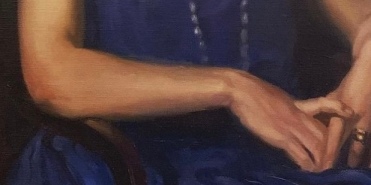ELIZABETH BOWEN AND THE DISSOLUTION OF THE NOVEL: Still Lives
by Andrew Bennett and Nicholas Royle
My previous review of these authors: https://dflewisreviews.wordpress.com/2015/01/22/this-thing-called-literature-andrew-bennett-nicholas-royle/
I have been rereading and reviewing all Elizabeth Bowen’s collected and uncollected stories in my personal fashion, and have found many references to ELBOWS as body parts and mentioned this fact in my still continuing reviews here: https://dflewisreviews.wordpress.com/31260-2/
I have been recently browsing through this book and seen its mere mention of Elbow as a name on page 139. There may be other references yet undiscovered. Just to say I am intrigued and inspired.


The Shadowy Third completes the hypotenuse with the elbow as one angle, if not the right angle. Gestalt real-time reviewing of a work needs triangulation by all its readers.
Further thoughts in comment stream below…



The introduction of this book mentions the ‘veiled cannibalism’ of Bowen, making me think more and more that there is, yes, more to the relationship of Aickman and Bowen, and why this is just one aspect of an essential synergy between them and their respective works, a synergy critics have missed heretofore.
It says in Abeyances: “Catalonia, catalepsy, cataplexy, then, are all crucial to our notion of still lives.”
Still Lives, as the essence of Zeno’s Paradox. A connsction between Bowen and Aickman that I discovered in recent months, before receiving this book today.
See Aickman’s Gluey Zenoism: https://dflewisreviews.wordpress.com/robert-aickman/
Abeyance now being the most apposite word for this? Null Immortalis.
“‘Still’ is never still; it keeps going. What does it mean to say that ‘still’ is not still, that ‘still’ keeps going, that sense keeps going?”
“And what is a clock? The accumulative, estranging repetition of ‘clock’ —together with the syntactical isolation of ‘ticking’ at the end of this still-life sentence —“
Cross-referenced with Simon Okotie’s BINDINGS in another Nicholas Royle book here: https://dflewisreviews.wordpress.com/2021/11/09/best-british-short-stories-2021/#comment-23378
“More disturbingly, however, one can be unknowingly inhabited by the crypt or crypt-effect of someone else — […] …the logic of cause and effect is placed in abeyance and becomes a function of reading itself. […] …a kind of wound, or, more accurately, a cicatrice …”
Cross-referenced with David Stonehouse concurrently here: https://nullimmortalis2010.wordpress.com/daniel-mills/#comment-764
And see another such cross-reference further below.
“The ‘surprising’ concatenation of slowness, a complexity and obscurity of thought processes, and the movement…” of the wrists.
“The grafting of people and trees erupts from the tomb of language,…”
“…a copulation of bodies and grammar.”
“…the work of reading, of the wound, is structured by the temporal and cognitive displacements of dread.”
NULL IMMORTALIS
“The event of arriving, coming in, is determined by its non-presence to itself, its going. This is still life — ‘being, still conscious, dead’.”
“Being in a dream wood suggests a strange, fairy-tale collusion of the oneiric and arboreal, commingles anthropomorphism and phantasmagoria, evokes the sense of a wood in a dream, the dreaminess of wood itself, and even the sense of a wood that dreams.”
Cf Into the Wood and Wood, two stories by Aickman.
“…the cannibalistic oddity of being had ‘on toast’…[…] …the comic outrage and cannibalistic impropriety of the ‘pure in heart’…”
“…a narrative that is at once interminable and multiple in itself — weaving and woven out of sheer kink.”
This whole book is in itself a highly concatenated version of the ‘synchronised shards of random truth and fiction’ in both Aickman and Bowen, seemingly without mentioning the former!
This book is a highly rarefied tour de force of fiction in its own right! So rarefied it will send you quite mad, beyond the fiction it describes. A meta-critique.
“…a ghostly doubling, coming back or revenance, as a work of what we propose to call the retrolexic…”
The Gluey Zenoism of both Bowen and Aickman as contemporaries with many mutual friends …
“Sheer kink is not a stop, not an end: it is indeed precisely because it fails to stop —“
My erstwhile reviews of Aickman: https://dflewisreviews.wordpress.com/robert-aickman/
“Rereading backwards: the sheer kink”
Or even kinkier, rereading randomly out of one of Ann Lee’s hats!?
I am not an expert nor a liker of Shakespeare, but from what I know, Bowen is nearer to Aickman in mutual synergy than to Shakespeare.
Thermo-writing in Bowen as a pervasive global warming, I understand from this 1995 book.
“‘The Little Girls’ is concerned with the disinterment of the past, as well as with burying things for the future.”
Cf David Storehouse’s Exile.
“To suggest that the past has to be read , that it is a construction of reading, is not to say that the present is in any sense more ‘real’.
I wonder how the arboREAL when replaced by the the ebook has affected reading and reality and retrolexia?
However one is entranced by Bowen’s ‘crypt effects’, ‘thermo-writing’, ‘mouth-events’, ‘dream woods’ and ‘auto-convulsions’, the apotheosis of Kink is undoubtedly Elbow.